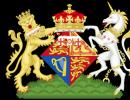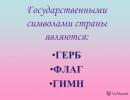The theorem is the opposite of the Pythagorean theorem formulation. Lesson "theorem is the inverse of the Pythagorean theorem." II. Checking homework
Lesson Objectives:
Educational: formulate and prove the Pythagorean theorem and the converse of the Pythagorean theorem. Show their historical and practical significance.
Developing: develop attention, memory, logical thinking students, the ability to reason, compare, draw conclusions.
Educational: to cultivate interest and love for the subject, accuracy, the ability to listen to comrades and teachers.
Equipment: Portrait of Pythagoras, posters with tasks for consolidation, textbook "Geometry" grades 7-9 (I.F. Sharygin).
Lesson plan:
I. Organizing time- 1 min.
II. Examination homework– 7 min.
III. introduction teachers, historical background - 4-5 min.
IV. Formulation and proof of the Pythagorean theorem - 7 min.
V. Formulation and proof of the theorem converse to the Pythagorean theorem - 5 min.
Fixing new material:
a) oral - 5-6 minutes.
b) written - 7-10 min.
VII. Homework - 1 min.
VIII. Summing up the lesson - 3 min.
During the classes
I. Organizational moment.
II. Checking homework.
p.7.1, No. 3 (at the board according to the finished drawing).
Condition: The height of a right triangle divides the hypotenuse into segments of length 1 and 2. Find the legs of this triangle.
BC = a; CA=b; BA=c; BD = a 1 ; DA = b 1 ; CD = hC
Additional question: write down the ratios in a right triangle.
 item 7.1, No. 5. Cut right triangle into three similar triangles.
item 7.1, No. 5. Cut right triangle into three similar triangles.
Explain.
ASN ~ ABC ~ SVN
(draw students' attention to the correct recording of the corresponding vertices of similar triangles)
III. Introductory speech of the teacher, historical background.
The truth will remain eternal, as soon as a weak person knows it!
And now the Pythagorean theorem is true, as in his distant age.
It is no coincidence that I began my lesson with the words of the German novelist Chamisso. Our lesson today is about the Pythagorean theorem. Let's write the topic of the lesson.
Before you is a portrait of the great Pythagoras. Born in 576 BC. After living 80 years, he died in 496 BC. Known as an ancient Greek philosopher and teacher. He was the son of the merchant Mnesarchus, who often took him on his trips, thanks to which the boy developed curiosity and a desire to learn new things. Pythagoras is a nickname given to him for his eloquence (“Pythagoras” means “persuasive speech”). He himself did not write anything. All his thoughts were recorded by his students. As a result of the first lecture he gave, Pythagoras acquired 2,000 students who, together with their wives and children, formed a huge school and created a state called “Great Greece”, which is based on the laws and rules of Pythagoras, revered as divine commandments. He was the first to call his reasoning about the meaning of life philosophy (philosophy). He was prone to mystification and demonstrative behavior. Once Pythagoras hid underground, and learned about everything that was happening from his mother. Then, withered like a skeleton, he declared in the public assembly that he had been in Hades, and showed amazing awareness of earthly events. For this, the touched inhabitants recognized him as God. Pythagoras never cried and was generally inaccessible to passions and excitement. He believed that he comes from a seed that is better compared to human. The whole life of Pythagoras is a legend that has come down to our time and told us about the most talented man of the ancient world.
IV. Formulation and proof of the Pythagorean theorem.
The formulation of the Pythagorean theorem is known to you from the course of algebra. Let's remember her.
In a right triangle, the square of the hypotenuse is equal to the sum of the squares of the legs.
However, this theorem was known many years before Pythagoras. 1500 years before Pythagoras, the ancient Egyptians knew that a triangle with sides 3, 4 and 5 is right-angled and used this property to build right angles when planning land plots and construction of buildings. In the oldest Chinese mathematical and astronomical work that has come down to us, “Zhiu-bi”, written 600 years before Pythagoras, among other sentences related to a right triangle, the Pythagorean theorem is also contained. Even earlier, this theorem was known to the Hindus. Thus, Pythagoras did not discover this property of a right-angled triangle; he was probably the first to generalize and prove it, to transfer it from the field of practice to the field of science.
Since ancient times, mathematicians have been finding more and more proofs of the Pythagorean theorem. There are over a hundred and fifty known. Let's recall the algebraic proof of the Pythagorean theorem, known to us from the course of algebra. (“Mathematics. Algebra. Functions. Data analysis” G.V. Dorofeev, M., “Bubblehead”, 2000).
 Invite students to remember the proof for the drawing and write it on the board.
Invite students to remember the proof for the drawing and write it on the board.
(a + b) 2 \u003d 4 1/2 a * b + c 2 b a
a 2 + 2a * b + b 2 \u003d 2a * b + c 2
a 2 + b 2 = c 2 a a b
The ancient Hindus, to whom this reasoning belongs, usually did not write it down, but accompanied the drawing with only one word: “Look.”
Let us consider in a modern presentation one of the proofs belonging to Pythagoras. At the beginning of the lesson, we remembered the theorem on ratios in a right triangle:
h 2 \u003d a 1 * b 1 a 2 \u003d a 1 * c b 2 \u003d b 1 * c
We add the last two equalities term by term:
b 2 + a 2 \u003d b 1 * c + a 1 * c \u003d (b 1 + a 1) * c 1 \u003d c * c \u003d c 2; a 2 + b 2 = c 2
Despite the apparent simplicity of this proof, it is far from being the simplest one. After all, for this it was necessary to draw a height in a right-angled triangle and consider similar triangles. Please write down this proof in your notebook.
V. Statement and proof of the theorem converse to the Pythagorean theorem.
What is the inverse of this theorem? (... if the condition and conclusion are reversed.)
Let's now try to formulate the theorem, the reverse of the Pythagorean theorem.
If in a triangle with sides a, b and c the equality with 2 \u003d a 2 + b 2 is true, then this triangle is right-angled, and the right angle is opposite to side c.
 (Proof of the inverse theorem on a poster)
(Proof of the inverse theorem on a poster)
ABC, BC = a,
AC = b, BA = c.
a 2 + b 2 = c 2
Prove:
ABC - rectangular,
 Proof:
Proof:
Consider a right triangle A 1 B 1 C 1,
where C 1 \u003d 90 °, A 1 C 1 \u003d a, A 1 C 1 \u003d b.
Then, according to the Pythagorean theorem, B 1 A 1 2 \u003d a 2 + b 2 \u003d c 2.
That is, B 1 A 1 \u003d c A 1 B 1 C 1 \u003d ABC on three sides of ABC - rectangular
C = 90°, which was to be proved.
VI. Consolidation of the studied material (orally).
1. According to the poster with ready-made drawings.
|
|
|
Fig.1: find AD if BD = 8, BDA = 30°.
Fig. 2: find CD if BE = 5, BAE = 45°.
Fig. 3: find BD if BC = 17, AD = 16.
2. Is a triangle right-angled if its sides are expressed by numbers:
5 2 + 6 2 ? 7 2 (no) |
9 2 + 12 2 = 15 2 (yes) |
15 2 + 20 2 = 25 2 (yes) |
What are the triples of numbers in the last two cases called? (Pythagorean).
VI. Problem solving (in writing).
No. 9. The side of an equilateral triangle is equal to a. Find the height of this triangle, the radius of the circumscribed circle, the radius of the inscribed circle.
№ 14. Prove that in a right triangle the radius of the circumscribed circle is equal to the median drawn to the hypotenuse and equal to half of the hypotenuse.
VII. Homework.
Item 7.1, pp. 175-177, analyze Theorem 7.4 (generalized Pythagorean theorem), No. 1 (oral), No. 2, No. 4.
VIII. Lesson results.
What new did you learn at the lesson today? …………
Pythagoras was first and foremost a philosopher. Now I want to read you a few of his sayings, which are relevant in our time for you and me.
- Do not raise dust on the path of life.
- Do only what in the future will not upset you and will not force you to repent.
- Never do what you do not know, but learn everything you need to know, and then you will lead a quiet life.
- Don't close your eyes when you want to sleep without understanding all your actions on the previous day.
- Learn to live simply and without luxury.
Subject: Theorem, converse theorem Pythagoras.
Lesson Objectives: 1) consider a theorem converse to the Pythagorean theorem; its application in the process of solving problems; consolidate the Pythagorean theorem and improve problem solving skills for its application;
2) develop logical thinking, creative search, cognitive interest;
3) to educate students in a responsible attitude to learning, a culture of mathematical speech.
Lesson type. A lesson in learning new knowledge.
During the classes
І. Organizing time
ІІ. Update knowledge
Lesson to mewouldwantedstart with a quatrain.
Yes, the path of knowledge is not smooth
But we know from school years
More mysteries than riddles
And there is no limit to the search!
So, in the last lesson, you learned the Pythagorean theorem. Questions:
The Pythagorean theorem is valid for which figure?
Which triangle is called a right triangle?
Formulate the Pythagorean theorem.
How will the Pythagorean theorem be written for each triangle?
What triangles are called equal?
Formulate signs of equality of triangles?
Now let's do a little independent work:
Solving problems according to drawings.
№1
(1 b.) Find: AB.
№2
(1 b.) Find: BC.
№3
( 2 b.)Find: AC
№4
(1 b.)Find: AC
№5 Given: ABCDrhombus
(2 b.) AB \u003d 13 cm
AC = 10cm
Find inD
Self Check #1. 5
№2. 5
№3. 16
№4. 13
№5. 24
ІІІ. Studying new material.
The ancient Egyptians built right angles on the ground in this way: they divided the rope into knots into 12 equal parts, tied its ends, after which the rope was stretched so on the ground that a triangle was formed with sides of 3, 4 and 5 divisions. The angle of the triangle, which lay opposite the side with 5 divisions, was right.
Can you explain the correctness of this judgment?
As a result of searching for an answer to the question, students should understand that from a mathematical point of view, the question is: will the triangle be right-angled.
We pose the problem: how, without making measurements, to determine whether a triangle with given sides is right-angled. Solving this problem is the purpose of the lesson.
Write down the topic of the lesson.
Theorem. If the sum of the squares of two sides of a triangle is equal to the square of the third side, then the triangle is a right triangle.
Independently prove the theorem (make up a proof plan according to the textbook).
From this theorem it follows that a triangle with sides 3, 4, 5 is a right-angled (Egyptian).
In general, numbers for which equality holds are called Pythagorean triples. And triangles whose side lengths are expressed by Pythagorean triples (6, 8, 10) are Pythagorean triangles.
Consolidation.
Because , then the triangle with sides 12, 13, 5 is not a right triangle.
Because , then the triangle with sides 1, 5, 6 is right-angled.
№ 430 (a, b, c)
( - is not)
The Pythagorean theorem says:
In a right triangle, the sum of the squares of the legs is equal to the square of the hypotenuse:
a 2 + b 2 = c 2,
- a And b- legs forming a right angle.
- With is the hypotenuse of the triangle.
Formulas of the Pythagorean theorem
- a = \sqrt(c^(2) - b^(2))
- b = \sqrt (c^(2) - a^(2))
- c = \sqrt (a^(2) + b^(2))
Proof of the Pythagorean Theorem
The area of a right triangle is calculated by the formula:
S = \frac(1)(2)ab
To calculate the area of an arbitrary triangle, the area formula is:
- p- semiperimeter. p=\frac(1)(2)(a+b+c) ,
- r is the radius of the inscribed circle. For a rectangle r=\frac(1)(2)(a+b-c).
Then we equate the right sides of both formulas for the area of a triangle:
\frac(1)(2) ab = \frac(1)(2)(a+b+c) \frac(1)(2)(a+b-c)
2 ab = (a+b+c) (a+b-c)
2 ab = \left((a+b)^(2) -c^(2) \right)
2ab = a^(2)+2ab+b^(2)-c^(2)
0=a^(2)+b^(2)-c^(2)
c^(2) = a^(2)+b^(2)
Inverse Pythagorean theorem:
If the square of one side of a triangle is equal to the sum of the squares of the other two sides, then the triangle is a right triangle. That is, for any triple of positive numbers a, b And c, such that
a 2 + b 2 = c 2,
there is a right triangle with legs a And b and hypotenuse c.
Pythagorean theorem- one of the fundamental theorems of Euclidean geometry, establishing the relationship between the sides of a right triangle. It was proved by the scientist mathematician and philosopher Pythagoras.
The meaning of the theorem in that it can be used to prove other theorems and solve problems.
Additional material:
Consideration of topics school curriculum with the help of video lessons is a convenient way to study and assimilate the material. Video helps to focus students' attention on the main theoretical points and not to miss important details. If necessary, students can always listen to the video lesson again or go back a few topics.
This 8th grade video lesson will help students learn new topic by geometry.
In the previous topic, we studied the Pythagorean theorem and analyzed its proof.
There is also a theorem which is known as the inverse Pythagorean theorem. Let's consider it in more detail.
Theorem. A triangle is right-angled if it satisfies the equality: the value of one side of the triangle squared is the same as the sum of the other two sides squared.

Proof. Suppose we are given a triangle ABC, in which the equality AB 2 = CA 2 + CB 2 is true. We need to prove that angle C is 90 degrees. Consider a triangle A 1 B 1 C 1 in which angle C 1 is 90 degrees, side C 1 A 1 is equal to CA and side B 1 C 1 is equal to BC.
Applying the Pythagorean theorem, we write the ratio of the sides in the triangle A 1 C 1 B 1: A 1 B 1 2 = C 1 A 1 2 + C 1 B 1 2 . By replacing the expression with equal sides, we get A 1 B 1 2 = CA 2 + CB 2.
We know from the conditions of the theorem that AB 2 = CA 2 + CB 2 . Then we can write A 1 B 1 2 = AB 2 , which implies that A 1 B 1 = AB.
We have found that in triangles ABC and A 1 B 1 C 1 three sides are equal: A 1 C 1 = AC, B 1 C 1 = BC, A 1 B 1 = AB. So these triangles are congruent. From the equality of triangles it follows that the angle C equal to the angle With 1 and respectively equal to 90 degrees. We have determined that triangle ABC is a right triangle and its angle C is 90 degrees. We have proved this theorem.

The author then gives an example. Suppose we are given an arbitrary triangle. The dimensions of its sides are known: 5, 4 and 3 units. Let's check the statement from the theorem converse to the Pythagorean theorem: 5 2 = 3 2 + 4 2 . If the statement is correct, then the given triangle is a right triangle.
In the following examples, the triangles will also be right-angled if their sides are equal:
5, 12, 13 units; the equality 13 2 = 5 2 + 12 2 is true;
8, 15, 17 units; the equation 17 2 = 8 2 + 15 2 is true;
7, 24, 25 units; the equation 25 2 = 7 2 + 24 2 is true.
The concept of the Pythagorean triangle is known. It is a right triangle whose side values are integers. If the legs of the Pythagorean triangle are denoted by a and c, and the hypotenuse b, then the values of the sides of this triangle can be written using the following formulas:
b \u003d k x (m 2 - n 2)
c \u003d k x (m 2 + n 2)
where m, n, k are any integers, and the value of m is greater than the value of n.

An interesting fact: a triangle with sides 5, 4 and 3 is also called the Egyptian triangle, such a triangle was known in ancient Egypt.
In this video tutorial, we got acquainted with the theorem, the converse of the Pythagorean theorem. Consider the proof in detail. Students also learned which triangles are called Pythagorean triangles.
Students can easily get acquainted with the topic "Theorem, the inverse of the Pythagorean theorem" on their own with the help of this video lesson.








